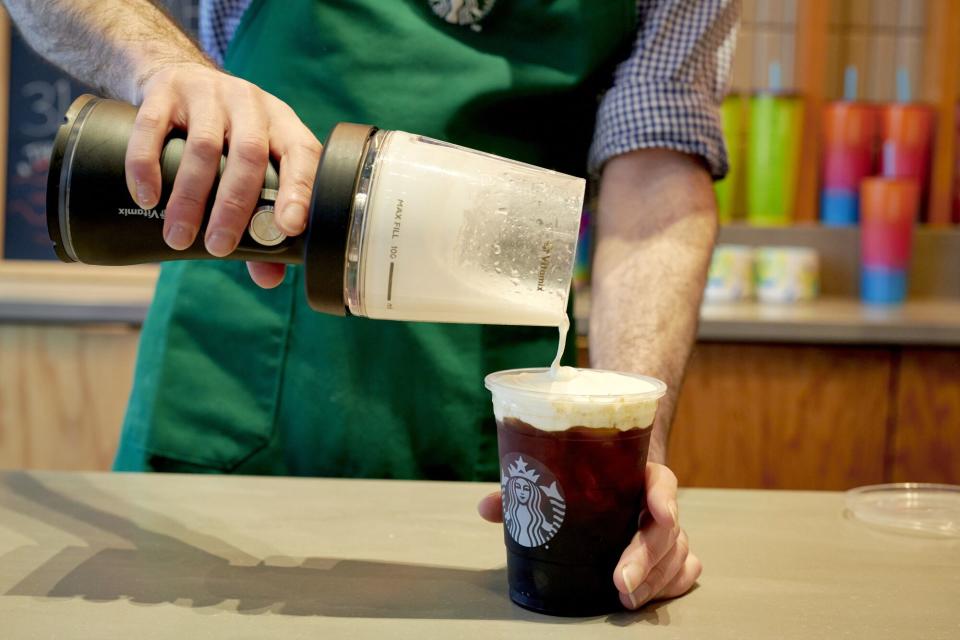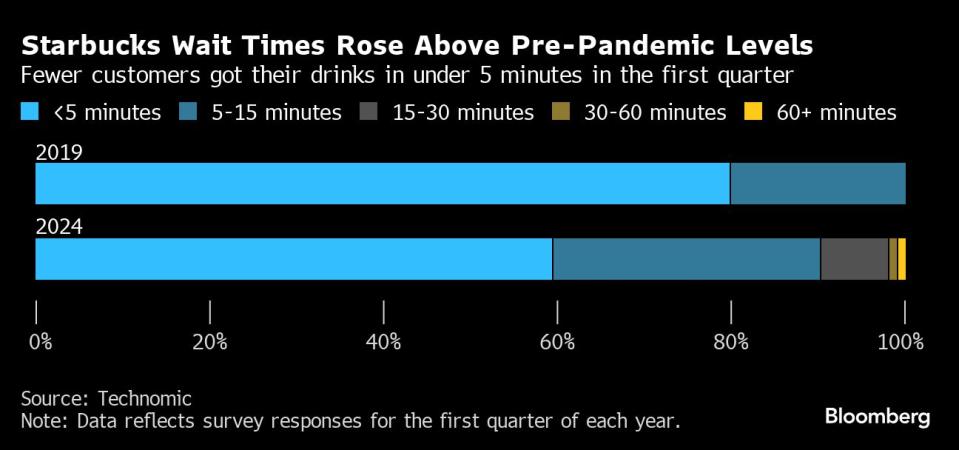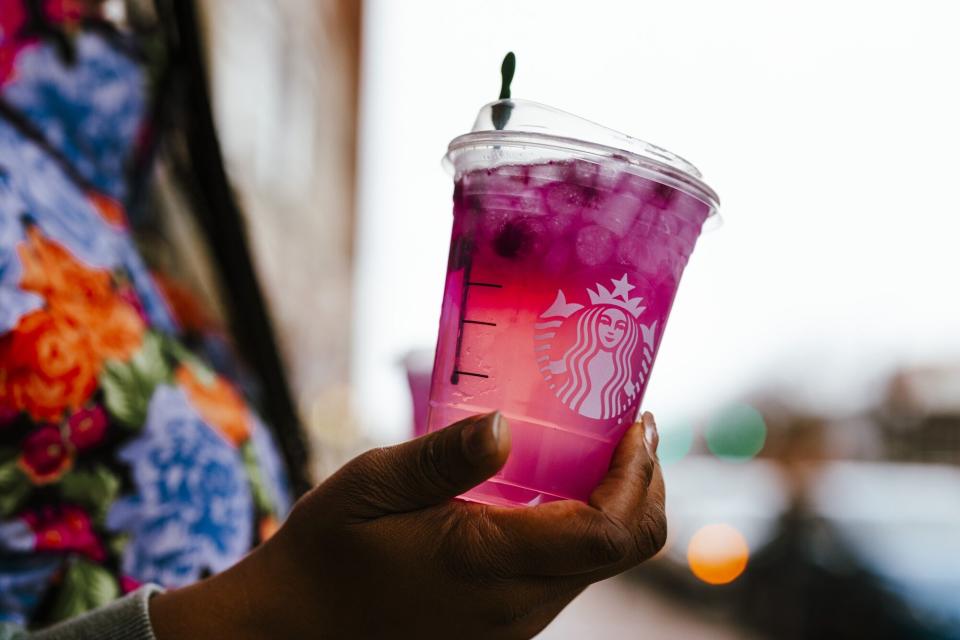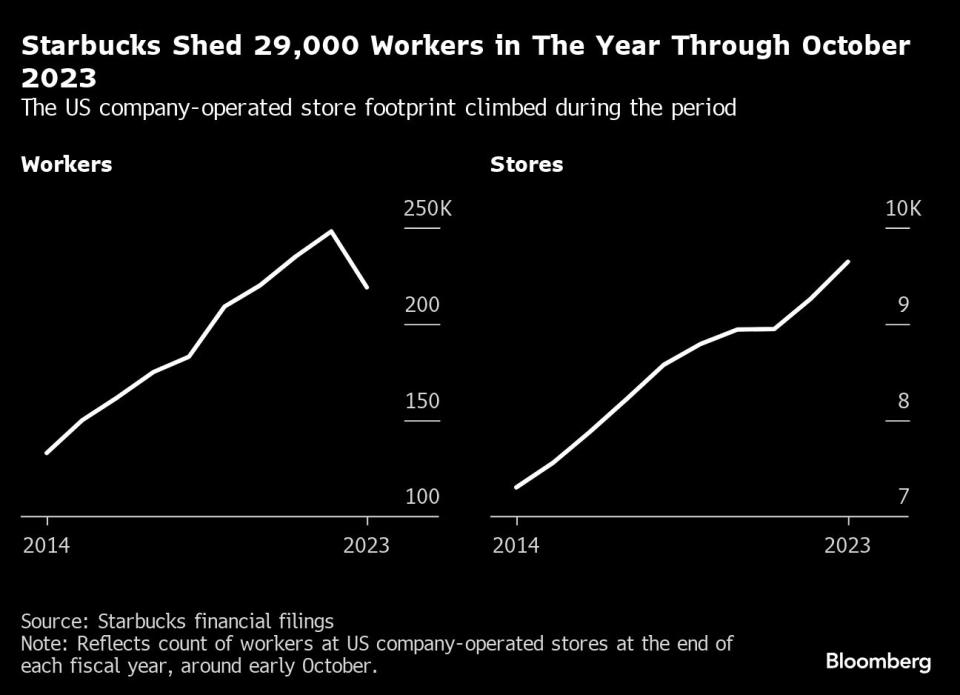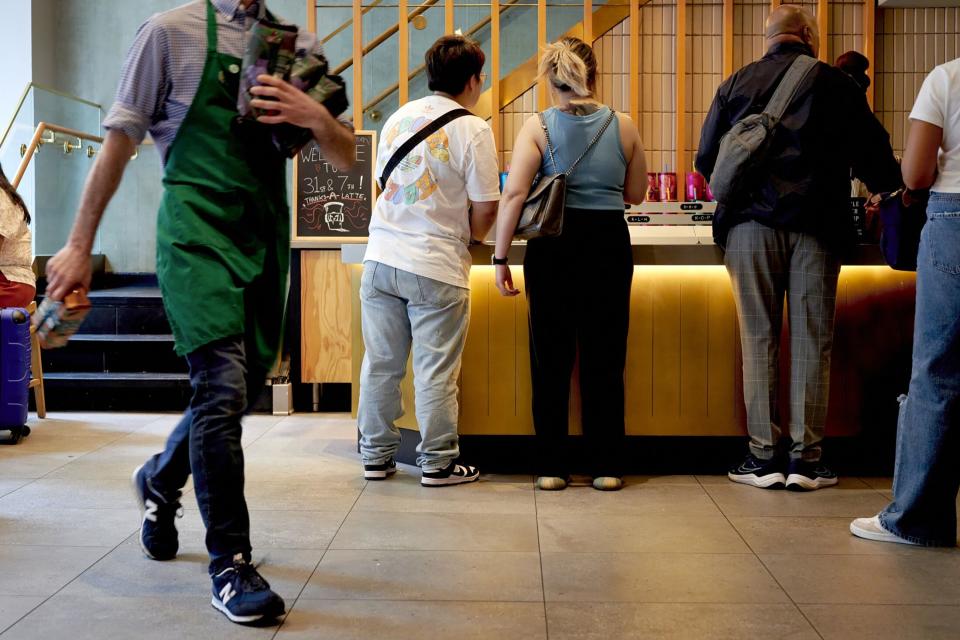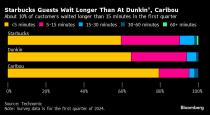40 Minutes for Starbucks Coffee? Customers and Workers Fume Over Fewer Staff
(Bloomberg) -- Starbucks baristas say they are confronting an alarming issue: Drink orders are coming in fast, but there are fewer people to prepare them.
Most Read from Bloomberg
World’s Largest Nuclear Plant Sits Idle While Energy Needs Soar
‘Not Gonna Be Pretty:’ Covid-Era Homebuyers Face Huge Rate Jump
Warning Signals Are Flashing for Homeowners in Texas and Florida
New BYD Hybrid Can Drive Non-Stop for More Than 2,000 Kilometers
In some stores where there used to be, say, five people making iced macchiatos and double-shot espressos just a year ago, now there are three or four, according to workers and managers who asked not to be identified because they aren’t authorized to speak publicly.
They blame the understaffing, in part, on an algorithm Starbucks Corp. uses to allocate store labor. The system takes into account an array of inputs — such as order forecasts and product availability — to spit out a recommended staffing plan. But many employees say that doesn’t adequately account for the time it takes to fulfill a ballooning number of special customer requests like extra espresso shots or cold foam, as well as the effect of more corporate promotions.
Workers are struggling to simultaneously juggle in-person, drive-thru, mobile and delivery orders and customers are waiting longer, these people say. About 8% of Starbucks customers waited between 15 and 30 minutes in the last quarter, compared to virtually no one waiting that long during the same period in 2019, according to data provider Technomic.
Starbucks disputes it’s understaffed, but acknowledged longer wait times contributed to the company’s first quarterly sales decline since 2020. The company has upgraded its labor algorithm and other staffing policies over the last 18 months to ensure “enough capacity to meet demand,” Chief Reinvention Officer Frank Britt said in an interview. He said Starbucks is rolling out new measures to reduce wait times and cut down on unfinished orders, including a plan to rejigger drink assembly to save workers time.
The worker frustration over the labor algorithm — the inner workings of which some employees say remain a mystery — is bubbling up as the chain’s quest for speed clashes with customer service, an issue intensified by a productivity push by Chief Executive Officer Laxman Narasimhan.
A process-oriented former management consultant, Narasimhan spent two decades at McKinsey before stints at PepsiCo Inc. and Reckitt Benckiser Group PLC. Since taking the helm at Starbucks just over a year ago, he has emphasized efficiency while asking baristas to spend time chatting with guests. Those competing demands have left some workers and customers feeling like Starbucks is doing neither warmth nor convenience very well.
One person pointed to a countdown clock placed near drive-thru windows as a physical manifestation of the pressure workers feel: It flashes red if baristas talk to customers for longer than the 30 seconds allotted per order. Starbucks said the clock helps supervisors know when to direct more workers to drive-thrus. Another person cited new checklists Narasimhan rolled out that help keep stores neat and orderly, but shift managers’ attention from spending time with their employees to crossing off to-do lists.On Mother’s Day this year, Chris Mills waited 40 minutes for a latte he was picking up as a treat for his wife. A regular at the Shelton, Connecticut, coffee shop near his home, the consumer products executive said he loved Starbucks’ “friendly little handwritten smiley face and a note sometimes on the cup.”
But that Sunday, Mills left Starbucks both disappointed and frustrated. “Nobody involved, in my observation, including me, the other customers, and even the staff seemed to be happy,” he said of watching six baristas scurry around to complete orders.
That’s the kind of negative review that underscore worries flagged by Howard Schultz, who built Starbucks into a global behemoth over three stints as CEO and remains the company’s largest individual shareholder.
“The stores require a maniacal focus on the customer experience,” Schultz wrote in a social media missive in May after Starbucks’ earnings miss.
Shares tumbled after the earnings report, extending the stock’s downward march. Through Tuesday, shares in Starbucks have dropped 22% under Narasimhan compared to a 35% rise in the S&P 500.
Schultz, who has twice returned to Starbucks after previous leaders floundered, publicly admonished executives and board members for the company’s sales performance and urged them to get into stores to work alongside baristas. Schultz said the company needs to be more experiential, not transactional.
Read More: Starbucks’ Ex-CEO Schultz Urges Big Fixes After Sales Miss
Britt, the Starbucks executive, called Mills’ Mother’s Day experience “unacceptable.”
“That’s on Starbucks,” Britt said. “We should be better.”
Following inquiries from Bloomberg News, Starbucks released a blog post Tuesday outlining efforts to ensure stores are adequately staffed. The company highlighted schedules set three weeks in advance that account for worker preferences in hours and shifts. Starbucks said employees are working more hours and earning more money, helping reduce worker turnover to pre-Covid levels.
Still, as part of the change, the company mandated all employees be willing to work at least 12 hours a week on average each quarter to keep their jobs, which people familiar with the store operations say has resulted in fewer baristas assigned to each location.
The move, which the company said was meant to help employees seeking additional hours, contributed to an overall winnowing of its workforce. Starbucks shed 29,000 workers at US company-operated stores in the year through October even as it added 380 stores, according to filings.
Starbucks has said baristas who work more hours can be faster since they get more practice. But now, when workers call out sick, managers say there are fewer people around to pick up shifts.
Starbucks said callouts are at record lows and workers at other stores can fill in shifts. Baristas may ascribe some problems to staffing issues even if they can be fixed in other ways, executives said.
Britt gives the example of a defective oven causing food orders to pile up. Customers get impatient and workers start to feel overwhelmed. To baristas, that kind of situation “feels like a staffing problem, because that’s how it shows up for them,” Britt said. But really, the company may just need to fix the oven. Likewise, when the algorithm re-allocates worker hours from later in the day to the morning rush because of a shift in demand, Starbucks said afternoon employees may feel like staffing has dropped even if the number of hours for the week has remained constant.
To counter hiccups the algorithm can’t predict, Britt said Starbucks has started to experiment at some stores with a position known as the “play caller.” The roving employee’s job is to spot issues and jump in to alleviate jams, whether they arise at cash registers, espresso machines or in the back of the store. Starbucks is betting that giving this person more visibility into what orders are coming in will let them intervene to fix problems faster. Starbucks plans to start rolling out the changes across the US this summer.
The company is also altering the way it makes drinks. For example, espresso shots — which can take an extra 26 seconds a pop, according to one employee — will now be made first rather than last. All those extra shots and syrups contribute $1 billion in revenue each year, according to Starbucks, but workers say they also take up a lot of their time.
Also adding to employee workloads is a a slate of new drinks and special deals the company is rolling out to stoke demand following a drop in transactions around the world during the first three months of 2024.
Read More: Starbucks CEO Says Faster Service, Boba Drinks Can Fix Chain
New drinks take time to learn and promotions bring surges of customers at times stores aren’t prepared for, people familiar with Starbucks’ operations said. What’s more, managers don’t always know about deals in time to adjust staffing.
Starbucks said it adjusts forecasts to account for promotions when possible, providing guidance to managers on how much extra labor is needed and how to allocate it throughout the day.
On a recent Monday, Michelle Eisen was the sole barista making drinks at her Buffalo, New York, location when an offer hit for $3 grande drinks. Customers flooded in. “I didn’t look up,” said Eisen, whose store sometimes makes as many as 154 drinks an hour.
Eisen, a 13-year Starbucks veteran who is among a group of workers trying to negotiate a union contract with the company, said baristas ranked staffing and scheduling as top concerns alongside pay and benefits in a recent survey.
She said she gives credit to Narasimhan for working to fix the issue, but wants to see more employees during busy times.
“If we’re staffed appropriately,” Eisen said. “Everybody’s happy.”
Read More: Starbucks Is Desperate to Cut the Wait for 383 Billion Lattes
--With assistance from Lily Meier, Demetrios Pogkas and Josh Eidelson.
Most Read from Bloomberg Businessweek
©2024 Bloomberg L.P.

 Yahoo Finance
Yahoo Finance 